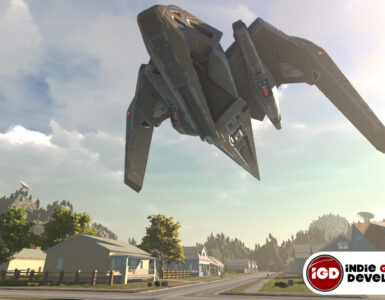Arcweave offers their insights for aspiring indie games writers and narrative designers.
Whether it’s the haunting mysteries of FNAF which spawned countless fan theories or the intricate, and still speculated, divergent narrative of Undertale, it is safe to say that indie gamers love a good story. With this rise of narrative-driven games, writers and narrative designers find themselves in a pivotal role. However, breaking into this field and finding your footing can be daunting. In this article, we’ll delve into the power and intricacies of narrative design in indie games, the importance of visibility, and the supportive role of the writing community.
An Indie Eye
A cornerstone of successful indie games is that they don’t attempt to compete with the ever-growing budget of AAA titles but rather have a keen understanding of, and appreciation for, the unique strengths of the indie genre. Unlike larger studios who are often bound to tried-and-tested industry trends, indie writers have the freedom to tackle diverse themes and explore weird and wonderful stories without being forced to compromise their creative vision.
This agility grants indie games the ability to cater to niche audiences which might be otherwise deemed commercially unviable by larger studios. Therefore, indie games can serve as an incredibly important platform for marginalized cultures and communities to be heard and celebrated.
Moreover, indie games have a distinct capacity for fostering meaningful connections between writers and players. Whether it’s through forums, social media, festivals, or conventions, game writers have the opportunity to grow a direct and personal relationship with their audience, cultivating a dedicated fan community who provide feedback, offer support, and engage with the game’s lore.
So, while indie game developers might be limited in terms of resources, these constrains force creators to defy conventions and break boundaries, breeding creativity and innovation which allows indie games to endure within a flooded market.
Democratization of Narrative Design
The democratization of game development tools and platforms has also played a crucial role in the endurance of indie games. With the rise of free game engines like Unity, Godot, Defold, and Unreal Engine, as well as the accessibility of distribution platforms like Steam and itch.io, aspiring game developers and writers can bring their ideas to life with relative ease.
Arcweave itself was born from this idea of lowering the barrier of entry to game development so that narrative designers from all backgrounds and experience levels can jump straight into scripting without requiring programming knowledge. This democratization of distribution eliminates the need for traditional gatekeepers like publishers or investors, empowering writers to independently showcase their work and build a dedicated fanbase.
Another great entry point for games writers is interactive fiction. Unlike other types of video games, interactive fiction primarily involves text-based choices and stories, allowing individuals to practice narrative design without the need for high-spec graphics, complex coding, or expensive software. One of the key factors driving the democratization of interactive fiction is the availability of user-friendly tools and platforms specifically designed for writers.
Platforms like Twine, Inky, Yarnspinner, and Arcweave provide intuitive interfaces that streamline the process of creating branching narratives. Arcweave in particular requires minimal technical expertise, allowing writers to focus on crafting branching narratives, complex characters, and meaningful choices that are neatly organised into one centralised hub. Therefore, while there are still many obstacles for indie game developers, the actual creative process of writing and designing has never been easier.
Writing to the Void
In the crowded indie game market, writers and narrative designers often find their work being lost to the sea of competition, becoming demotivated by the lack of audience support. However, it’s important to understand that writing for the sake of writing is innately valuable by itself; practice and repetition not only helps writers improve but it can (and should) also just be a fun way to pass the time. Focus on writing what you enjoy first, and then see where the overlap is with what your audience enjoys – that’s the golden sweet spot.
Furthermore, it’s important for games writers to recognise that their lore and story should not only captivate the current players but also draw attention to the game more generally. Especially in smaller studios, writers will often need at least some level of proficiency with marketing tie-ins and community engagement.
Consider which parts of the game’s story will build the most anticipation without being spoiler-heavy, practice styling and formatting short excerpts across different social media platforms. Contemplate the in-game story and how its presentation might translate to platforms like Twitter and Discord. How is your story different? Why should people stop to listen?
Social media management isn’t the only external factor to consider either. Events such as Steam’s Next Fest and game showcases like Arcweave’s showcase page are also incredibly important in increasing visibility and gaining those important wishlists in the run up to launch. Narrative in games is an inherently multidisciplinary practice which requires a broad set of skills, so always be open to learning.
Arcweave – The Tool for Narrative Design
With all of these challenges that games writers and narrative designers face, organization and collaboration are paramount. This is where tools like Arcweave come into play. Arcweave provides a robust platform for visualizing and structuring complex narratives, enabling game writers and designers to streamline their workflow and bring their ideas to life with ease.
With Arcweave, you can map out story branches, design character arcs, and manage dialogue trees with intuitive drag-and-drop functionality. Whether you’re working solo or with a team, Arcweave’s web-based software allows you to jump right into designing and collaborate with others in real-time. Our free plugins for Unity, Unreal Engine, and Godot enables seamless integration with your game engine of choice, making scripting and implementing narrative design easier than ever.
To all the aspiring indie game writers and narrative designers, the path ahead may be challenging, but it’s also brimming with boundless potential. Embrace the power of indie storytelling, dive into one of the many free tools out there, and just start creating! And remember, Arcweave is here to support you every step of the way. So, what are you waiting for?
Check out Arcweave for free today and join our thriving community of likeminded creatives!
Check out Arcweave: https://arcweave.com/
Follow Arcweave on Twitter: https://twitter.com/arcweave
Join our Discord community: https://discord.gg/arcweave














